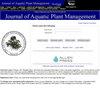dentification and prioritization of sites with overwintering cyanobacteria to inform preventative management of harmful algal blooms
IF 0.9
4区 生物学
Q3 MARINE & FRESHWATER BIOLOGY
引用次数: 0
Abstract
Cyanobacteria causing harmful algal blooms (HABs) can overwinter in sediments as quiescent cells (akinetes or vegetative colonies) and contribute to bloom resurgences. Targeting overwintering cells in sediments for preventative management may provide a viable approach to delay onset and mitigate blooms. However, there are limited resources for this novel strategy. Given the growing global impact of HABs, the ability to identify and prioritize sites that are influenced by overwintering cells will be a critical step for preventative management. Therefore, the overall objective of this study was to identify and illustrate relevant data to support identification and prioritization of sites that contain overwintering cells with the potential to form HABs. To achieve this, sediment samples were collected from three HAB-affected reservoirs (Marion Reservoir, KS; Fort Gibson Lake, OK, and Heyburn Lake, OK) as pertinent examples. Cyanobacteria enumeration and growth potential data from incubation studies were assembled for prioriti-zation. Overwintering cells were present in all HAB-affected reservoirs, with 85% of sites (n ¼ 13) containing overwin-tering cells in sediments and 54% of sites (n ¼ 13) with a planktonic growth potential producing problematic cell densities (. 100,000 cells ml1). On the basis of the weight of evidence, Marion Reservoir, followed by Fort Gibson, and last, Heyburn Lake, have the greatest potential for over-wintering cells to contribute to HABs. These data indicate that a monitoring approach should consider at least two lines of evidence: 1) presence and density of overwintering cyanobacteria and 2) growth potential as informed by laboratory incubation studies to predict growth risk and prioritize locations for preventative management.确定有越冬蓝藻的地点并确定其优先顺序,为有害藻华的预防性管理提供信息
引起有害藻华(HABs)的蓝藻可以在沉积物中作为静止细胞(活动菌或营养菌落)越冬,并有助于藻华的恢复。针对沉积物中的越冬细胞进行预防性管理可能为延缓和减轻藻华提供了可行的方法。然而,这种新策略的资源有限。鉴于有害藻华对全球的影响越来越大,识别和优先考虑受越冬细胞影响的地点的能力将是预防性管理的关键一步。因此,本研究的总体目标是确定和说明相关数据,以支持识别和优先考虑含有可能形成有害藻华的越冬细胞的地点。为了实现这一目标,从三个受赤潮影响的水库(Marion水库,KS;吉布森堡湖(Fort Gibson Lake, OK)和海本湖(Heyburn Lake, OK)都是相关的例子。蓝藻枚举和生长潜力的数据从孵化研究组装优先级。所有受赤潮影响的水库中都存在越冬细胞,沉积物中85%的地点(n¼13)含有越冬细胞,54%的地点(n¼13)具有浮游生长潜力,产生了问题的细胞密度(n¼13)。100,000 cells ml1)。根据证据的重量,马里恩水库,其次是吉布森堡,最后是海本湖,具有最大的越冬细胞促进赤潮的潜力。这些数据表明,监测方法应考虑至少两方面的证据:1)越冬蓝藻的存在和密度;2)实验室孵化研究提供的生长潜力,以预测生长风险并优先考虑预防性管理的地点。
本文章由计算机程序翻译,如有差异,请以英文原文为准。
求助全文
约1分钟内获得全文
求助全文

 求助内容:
求助内容: 应助结果提醒方式:
应助结果提醒方式:


